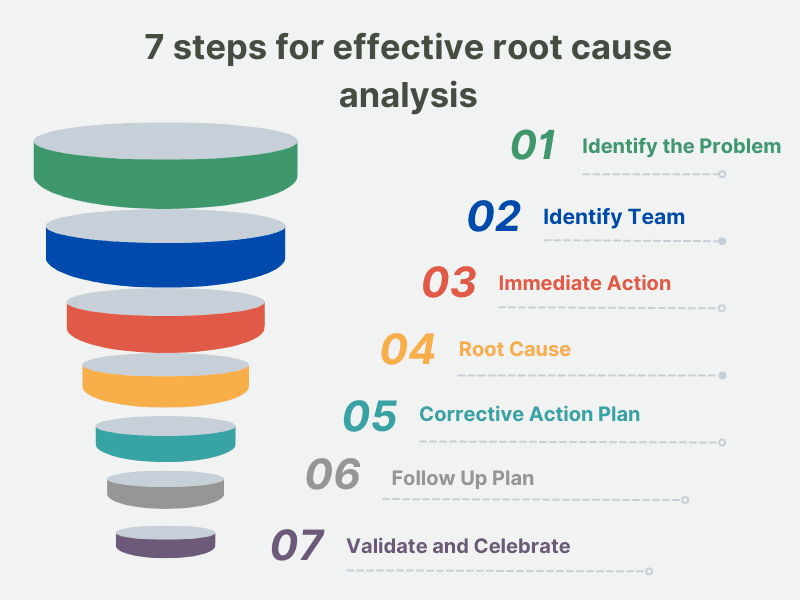Table of Contents
Toggle7 steps of effective root cause analysis
What is root cause analysis
Root Cause =
- The causal or contributing factors that, if corrected, would prevent recurrence of the identified problem
- The “factor” that caused a problem or defect and should be permanently eliminated through process improvement
- The factor that sets in motion the cause and effect chain that creates a problem
- The “true” reason that contributed to the creation of a problem, defect or nonconformance
Root cause analysis is a standard process of :
- Identifying a problem
- Containing and analyzing the problem
- Defining the root cause
- Defining and implementing the actions required to eliminate the root cause
- Validating that the corrective action prevented recurrence of problem
7 steps for effective root cause analysis and Problem Solving Process

Step #1 Identify the Problem
Clearly state the problem the team is to solve, teams should refer back to problem statement to avoid getting off track
Use 5W2H approach
- Who? Individuals/customers associated with problem
- What? The problem statement or definition
- When? Date and time problem was identified
- Where? Location of complaints (area, facilities, customers)
- Why? Any previously known explanations
- How? How did the problem happen (root cause) and how will the problem be corrected (corrective action)?
- How Many? Size and frequency of problem
Step #2 Identify Team
When a problem cannot be solved quickly by an individual, use a team!
- Should consist of domain knowledge experts
- Small group of people (4-10) with process and product knowledge, available time and authority to correct the problem
- Must be empowered to “change the rules”
- Should have a designated Champion
- Membership in team is always changing!
Key Ideas for Team Success
- Define roles and responsibilities
- Identify external customer needs
- Identify internal customer needs
- Appropriate levels of organization present
- Clearly defined objectives and outputs
- Solicit input from everyone!
- Good meeting location
– near work area for easy access to info
– quiet for concentration and avoiding distractions
Roles and Responsibilities
- Champion: Mentor, guide and direct teams, advocate to upper management
- Leader: day-to-day authority, calls meetings, facilitation of team, reports to Champion
- Record Keeper: Writes and publishes minutes
- Participants: Respect all ideas, keep an open mind, know their role within team
Step #3 Immediate Action
- Must isolate effects of problem from customer
- Usually “Band-aid” fixes
- Re-inspection before shipping
- Rework if required
- Recall parts/documents from customer or storage
- only temporary until corrective action is implemented
- must also verify that immediate action is effective
- Must sure another problem does not arise from the temporary solutions
Step #4 Root Cause
- Brainstorm possible causes of problem with team
- Organize causes with Cause and Effect Diagram
- “Pareto” the causes to identify those most likely or occurring most often
- Use 5 Why? method to further define the root cause of symptoms
–May involve additional research/analysis/investigation to get to each “Why?”
- Must identify the process that caused the problem
–if root cause is company-wide, elevate these process issues (outside of team control) to upper management to address
Tools used
- Brainstorming
- 5 Why or Five Why
- 6M Analysis (Ishikawa/Fish bone diagram)
- flowcharting
- cause & effect diagrams
- pareto charts
- barrier analysis
- change analysis
- failure mode, effect & criticality analysis
- fault tree analysis
Step #5 Corrective Action Plan
- Must verify the solution will eliminate the problem, Verification before implementation whenever possible
- Define exactly, What actions will be taken to eliminate the problem? Who is responsible? When will it be completed?
- Make certain customer is happy with actions
- Define how the effectiveness of the corrective action will be measured.
- Verification–Assures that at a point in time, the action taken will actually do what is intended without causing another problem
- Validation–Provides measurable evidence over time that the action taken worked properly, and problem has not recurred
Step #6 Follow Up Plan
- What actions will be completed in the future to ensure that the root cause has been eliminated by this corrective action?
- Who will look at what data?
- How long after the action plan will this be done?
- What criteria in the data results will determine that the problem has not recurred?
Step #7 Validate and Celebrate
- What were the results of the follow up?
- If problem did reoccur, go back to Step #4 and re-evaluate root cause, then re-evaluate corrective action in Step #5
- If problem did not reoccur, celebrate team success!
- Document savings to publicize team effort, obtain customer satisfaction and continued management support of teams
Note:
- One problem may have more than one root cause
- One root cause may be contributing to many problems
- When the root cause is not addressed, expect the problem to reoccur
- Prevention is the key!